高三英语常用形容词比较级和最高级等结构小结
- 格式:pdf
- 大小:11.03 KB
- 文档页数:3

高中英语知识点归纳比较级和最高级的句型比较级和最高级的句型是英语中常用的一种语法结构,用来进行比较和描述物品或人的相对程度。
下面是有关比较级和最高级句型的归纳和总结。
1. 比较级的结构:a) 主语 + be (或其他系动词) + 形容词/副词 + 比较级 + than + 宾语例:Tom is taller than his brother.She runs faster than me.b) 主语 + 动词 + 形容词/副词 + 比较级 + than + 宾语例:My car runs faster than yours.They work harder than us.2. 最高级的结构:a) 主语 + be (或其他系动词) + the + 最高级 + of + 宾语 (当宾语是可数名词时)例:She is the smartest student in the class.He is the tallest boy in the group.b) 主语 + 动词 + the + 最高级 + of + 宾语 (当宾语是可数名词时)例:This book is the most interesting one of all.They are the best athletes in the team.3. 比较级和最高级的句型常用于以下情境:a) 比较两者之间的差异或相似程度- 比较级:A is + 形容词/副词 + than B例:This car is more expensive than that one.He works harder than his sister.- 最高级:A is the + 最高级 + of (all/in) B 例:This is the longest bridge in the country.She is the smartest student in the class.b) 描述一组三者或多者之间的差异或相似程度 - 比较级:A is + 形容词/副词 + than B and C 例:This car is faster than any other car in the race. He runs more quickly than his siblings.- 最高级:A is the + 最高级 + in/of (all) B and C 例:This is the biggest park in the city.She is the tallest among all her friends.4. 比较级和最高级的形容词和副词变化规则:a) 一般形容词/副词 + -er (比较级) + -est (最高级)例:fast - faster - fastesttall - taller - tallestb) 以-e结尾的形容词/副词 + -r (比较级) + -st (最高级)例:large - larger - largestnice - nicer - nicestc) 重读闭音节,末尾只有一个辅音字母的形容词/副词,需双写最后一个辅音字母 + -er (比较级) + -est (最高级)例:big - bigger - biggesthot - hotter - hottest总结:比较级和最高级的句型是一种用来进行比较和描述相对程度的常用语法结构。
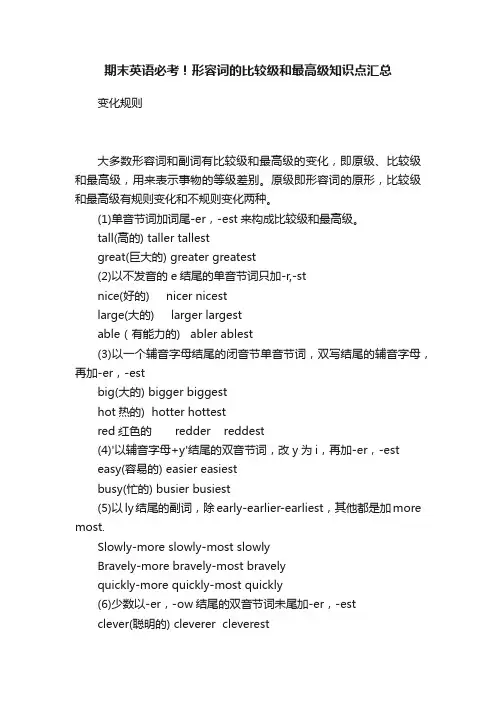
期末英语必考!形容词的比较级和最高级知识点汇总变化规则大多数形容词和副词有比较级和最高级的变化,即原级、比较级和最高级,用来表示事物的等级差别。
原级即形容词的原形,比较级和最高级有规则变化和不规则变化两种。
(1)单音节词加词尾-er,-est来构成比较级和最高级。
tall(高的) taller tallestgreat(巨大的) greater greatest(2)以不发音的e结尾的单音节词只加-r,-stnice(好的) nicer nicestlarge(大的) larger largestable(有能力的) abler ablest(3)以一个辅音字母结尾的闭音节单音节词,双写结尾的辅音字母,再加-er,-estbig(大的) bigger biggesthot热的) hotter hottestred红色的 redder reddest(4)'以辅音字母+y'结尾的双音节词,改y为i,再加-er,-esteasy(容易的) easier easiestbusy(忙的) busier busiest(5)以ly结尾的副词,除early-earlier-earliest,其他都是加more most.Slowly-more slowly-most slowlyBravely-more bravely-most bravelyquickly-more quickly-most quickly(6)少数以-er,-ow结尾的双音节词未尾加-er,-estclever(聪明的) cleverer cleverestnarrow(窄的) narrower narrowest(7)其他双音节词和多音节词在前面加more,most来构成比较级和最高级。
如:important(重要的) more important most importanteasily(容易地) more easily most easily(8)一些词的比较级和最高级,可以加-er或 -est,也可以加more 或most如:clever, polite等。
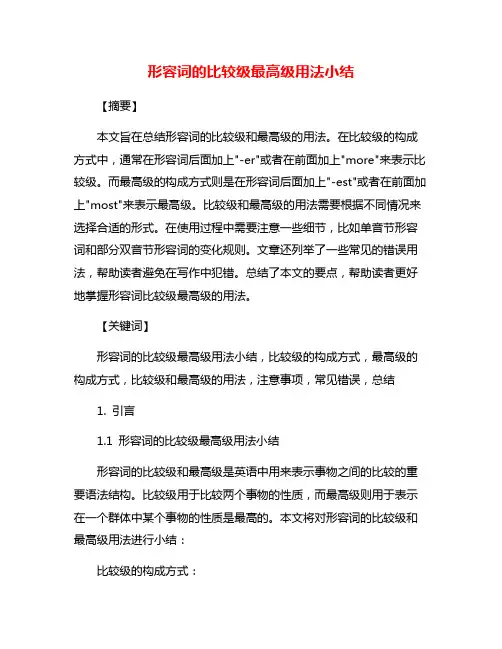
形容词的比较级最高级用法小结【摘要】本文旨在总结形容词的比较级和最高级的用法。
在比较级的构成方式中,通常在形容词后面加上"-er"或者在前面加上"more"来表示比较级。
而最高级的构成方式则是在形容词后面加上"-est"或者在前面加上"most"来表示最高级。
比较级和最高级的用法需要根据不同情况来选择合适的形式。
在使用过程中需要注意一些细节,比如单音节形容词和部分双音节形容词的变化规则。
文章还列举了一些常见的错误用法,帮助读者避免在写作中犯错。
总结了本文的要点,帮助读者更好地掌握形容词比较级最高级的用法。
【关键词】形容词的比较级最高级用法小结,比较级的构成方式,最高级的构成方式,比较级和最高级的用法,注意事项,常见错误,总结1. 引言1.1 形容词的比较级最高级用法小结形容词的比较级和最高级是英语中用来表示事物之间的比较的重要语法结构。
比较级用于比较两个事物的性质,而最高级则用于表示在一个群体中某个事物的性质是最高的。
本文将对形容词的比较级和最高级用法进行小结:比较级的构成方式:一般在形容词后面加上“-er”,如“bigger”、“faster”等。
但也有一些形容词需要在前面加上“more”来表示比较级,如“more beautiful”、“more expensive”等。
有些形容词的比较级形式是不规则的,需要进行记忆,如“good”变为“better”、“bad”变为“worse”等。
比较级用于比较两个事物的性质,通常用“than”连接两个比较对象,如“My car is faster than yours”。
最高级用于表示在一个群体中某个事物的性质是最高的,通常用“the”来引导最高级,如“She is the tallest girl in the class”。
常见错误:一些学习者常常混淆不规则形式的比较级和最高级,需多加练习来熟练记忆。
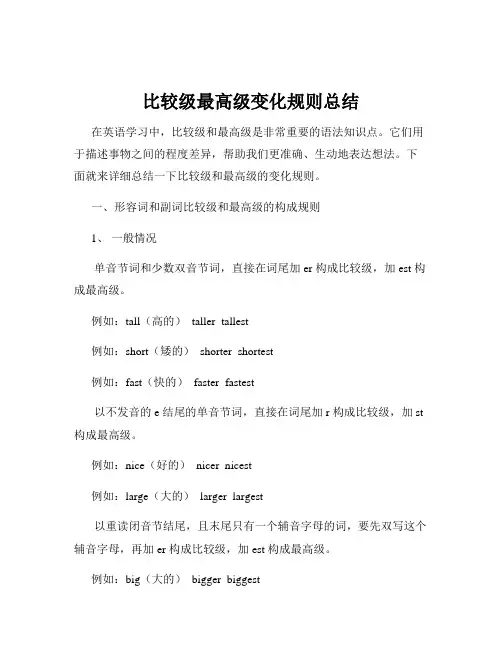
比较级最高级变化规则总结在英语学习中,比较级和最高级是非常重要的语法知识点。
它们用于描述事物之间的程度差异,帮助我们更准确、生动地表达想法。
下面就来详细总结一下比较级和最高级的变化规则。
一、形容词和副词比较级和最高级的构成规则1、一般情况单音节词和少数双音节词,直接在词尾加 er 构成比较级,加 est 构成最高级。
例如:tall(高的) taller tallest例如:short(矮的) shorter shortest例如:fast(快的) faster fastest以不发音的 e 结尾的单音节词,直接在词尾加 r 构成比较级,加 st 构成最高级。
例如:nice(好的) nicer nicest例如:large(大的) larger largest以重读闭音节结尾,且末尾只有一个辅音字母的词,要先双写这个辅音字母,再加 er 构成比较级,加 est 构成最高级。
例如:big(大的) bigger biggest例如:hot(热的) hotter hottest例如:thin(瘦的) thinner thinnest2、多音节词和部分双音节词在词前加 more 构成比较级,加 most 构成最高级。
例如:beautiful(美丽的) more beautiful most beautiful例如:important(重要的) more important most important例如:difficult(困难的) more difficult most difficult3、不规则变化有些形容词和副词的比较级和最高级变化是不规则的,需要特别记忆。
例如:good(好的) better best例如:bad(坏的) worse worst例如:many / much(许多) more most例如:little(少的) less least例如:far(远的) farther / further farthest / furthest二、比较级和最高级的用法1、比较级的用法表示两者之间的比较,常用“than”连接。
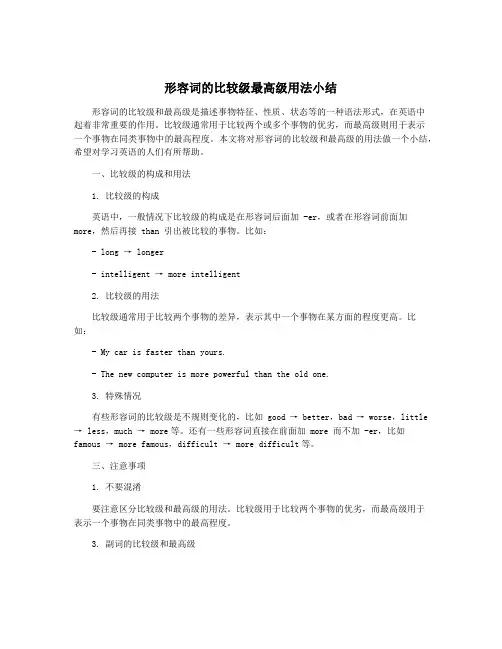
形容词的比较级最高级用法小结形容词的比较级和最高级是描述事物特征、性质、状态等的一种语法形式,在英语中起着非常重要的作用。
比较级通常用于比较两个或多个事物的优劣,而最高级则用于表示一个事物在同类事物中的最高程度。
本文将对形容词的比较级和最高级的用法做一个小结,希望对学习英语的人们有所帮助。
一、比较级的构成和用法1. 比较级的构成英语中,一般情况下比较级的构成是在形容词后面加 -er,或者在形容词前面加more,然后再接 than 引出被比较的事物。
比如:- long → longer- intelligent → more intelligent2. 比较级的用法比较级通常用于比较两个事物的差异,表示其中一个事物在某方面的程度更高。
比如:- My car is faster than yours.- The new computer is more powerful than the old one.3. 特殊情况有些形容词的比较级是不规则变化的,比如good → better,bad → worse,little → less,much → more等。
还有一些形容词直接在前面加 more 而不加 -er,比如famous → more famous,difficult → more difficult等。
三、注意事项1. 不要混淆要注意区分比较级和最高级的用法。
比较级用于比较两个事物的优劣,而最高级用于表示一个事物在同类事物中的最高程度。
3. 副词的比较级和最高级与形容词一样,副词也有比较级和最高级的变化,只是它们的构成方式不同。
一般情况下副词的比较级在其原形后面加上 -er,或者在其原形前面加 more,最高级在其原形前面加上 the most。

英语语法比较级和最高级用法知识点归纳总结一、比较级的用法1. 用于比较两个人或事物之间的差异或程度,常用结构为“as +原级+ as”或“not as/so +形容词/副词+ as”。
例如:- Mary is as tall as her sister.- This book is not as interesting as the one I read yesterday.2. 用于比较两种情况或行为的差异,常用结构为“比较级+ than”。
例如:- I prefer coffee to tea.- He runs faster than his friend.3. 用于表示“越来越……”的意思,常用结构为“比较级 + and + 比较级”。
例如:- The weather is getting colder and colder.- He is becoming more and more confident.4. 比较级的特殊形式:- 以字母e结尾的形容词,去掉e再加-er。
- 以重读闭音节结尾的单音节形容词和部分双音节形容词,直接加-er。
- 以“辅音字母+y”结尾的形容词,把y变成i再加-er。
例如:- nice → nicer- big → bigger- happy → happier二、最高级的用法1. 用于三个或三个以上人或事物之间的比较,表示最高程度,常用结构为“the + 最高级”。
例如:- She is the tallest girl in the class.- This is the most interesting book I've ever read.2. 最高级的特殊形式:- 以字母e结尾的形容词,去掉e再加-st。
- 以重读闭音节结尾的单音节形容词和部分双音节形容词,直接加-st。
- 以“辅音字母+y”结尾的形容词,把y变成i再加-est。
例如:- nice → nicest- big → biggest- happy → happiest三、比较级和最高级的不规则形式1. 比较级和最高级的不规则形式:good → better → best, bad → worse → worst, many/much → more → most, little → less→ least。
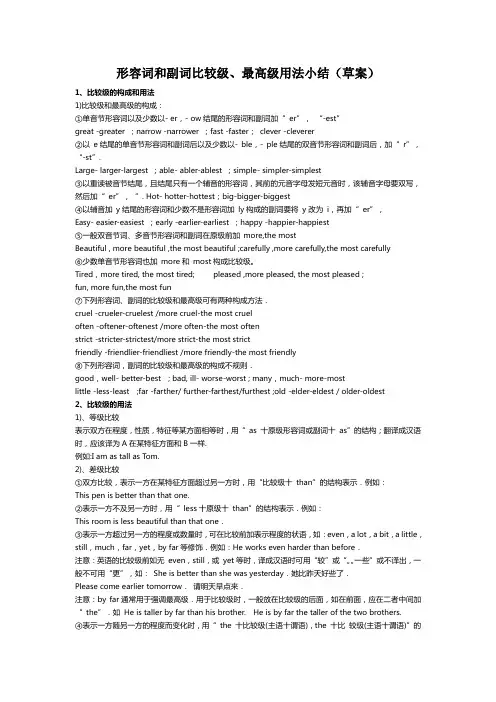
形容词和副词比较级、最高级用法小结(草案)1、比较级的构成和用法1)比较级和最高级的构成:①单音节形容词以及少数以- er,- ow结尾的形容词和副词加“er”,“-est”great -greater ;narrow -narrower ;fast -faster;clever -cleverer②以e结尾的单音节形容词和副词后以及少数以- ble,- ple结尾的双音节形容词和副词后,加“r”,“-st”.Large- larger-largest ;able- abler-ablest ;simple- simpler-simplest③以重读被音节结尾,且结尾只有一个辅音的形容词,其前的元音字母发短元音时,该辅音字母要双写,然后加“er”,“ . Hot- hotter-hottest;big-bigger-biggest④以辅音加y结尾的形容词和少数不是形容词加ly构成的副词要将y改为i,再加“er”,Easy- easier-easiest ;early -earlier-earliest ;happy -happier-happiest⑤一般双音节词、多音节形容词和副词在原级前加more,the mostBeautiful , more beautiful ,the most beautiful ;carefully ,more carefully,the most carefully⑥少数单音节形容词也加more和most构成比较级。
Tired,more tired, the most tired; pleased ,more pleased, the most pleased ;fun, more fun,the most fun⑦下列形容词、副词的比较级和最高级可有两种构成方法.cruel -crueler-cruelest /more cruel-the most crueloften -oftener-oftenest /more often-the most oftenstrict -stricter-strictest/more strict-the most strictfriendly -friendlier-friendliest /more friendly-the most friendly⑧下列形容词,副词的比较级和最高级的构成不规则.good,well- better-best ; bad, ill- worse-worst ; many,much- more-mostlittle -less-least ;far -farther/ further-farthest/furthest ;old -elder-eldest/older-oldest2、比较级的用法1)、等级比较表示双方在程度,性质,特征等某方面相等时,用“as 十原级形容词或副词十as”的结构;翻译成汉语时,应该译为A在某特征方面和B一样.例如:I am as tall as Tom.2)、差级比较①双方比较,表示一方在某特征方面超过另一方时,用“比较级十than”的结构表示.例如:This pen is better than that one.②表示一方不及另一方时,用“less十原级十than”的结构表示.例如:This room is less beautiful than that one.③表示一方超过另一方的程度或数量时,可在比较前加表示程度的状语,如:even,a lot,a bit,a little,still,much,far,yet,by far等修饰.例如:He works even harder than before.注意:英语的比较级前如无even,still,或yet等时,译成汉语时可用“较”或“……一些”或不译出,一般不可用“更”,如:She is better than she was yesterday.她比昨天好些了.Please come earlier tomorrow.请明天早点来.注意:by far通常用于强调最高级.用于比较级时,一般放在比较级的后面,如在前面,应在二者中间加“the”.如He is taller by far than his brother. He is by far the taller of the two brothers.④表示一方随另一方的程度而变化时,用“the 十比较级(主语十谓语),the 十比较级(主语十谓语)”的结构.例如:The harder he works,the happier he feels.⑤不与其它事物相比,表示本身程度的改变时,用“比较级十and十比较级”的结构.例如:The weather is getting colder and colder. The girl becomes more and more beautiful.⑥某些以一or结尾的形容词进行比较时,用to代替than.(这些词有inferior,superior,junior,senior,prior等.例如:He is superior to Mr Wang in mathematics.⑦在比较从句中为了避免重复,我们通常用that(those),one(ones)代替前面出现的名词。
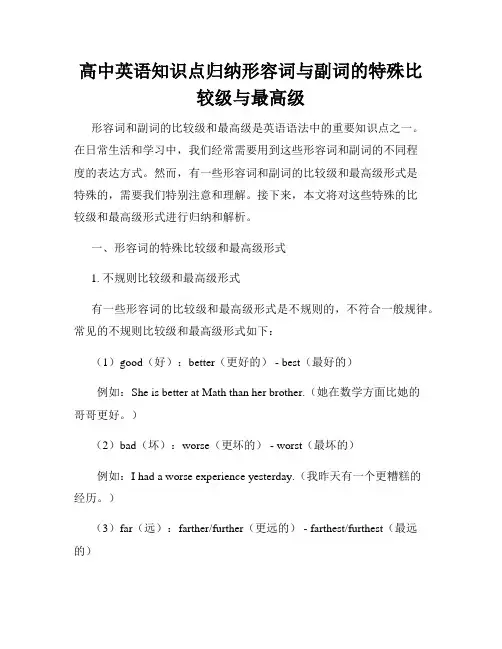
高中英语知识点归纳形容词与副词的特殊比较级与最高级形容词和副词的比较级和最高级是英语语法中的重要知识点之一。
在日常生活和学习中,我们经常需要用到这些形容词和副词的不同程度的表达方式。
然而,有一些形容词和副词的比较级和最高级形式是特殊的,需要我们特别注意和理解。
接下来,本文将对这些特殊的比较级和最高级形式进行归纳和解析。
一、形容词的特殊比较级和最高级形式1. 不规则比较级和最高级形式有一些形容词的比较级和最高级形式是不规则的,不符合一般规律。
常见的不规则比较级和最高级形式如下:(1)good(好):better(更好的) - best(最好的)例如:She is better at Math than her brother.(她在数学方面比她的哥哥更好。
)(2)bad(坏):worse(更坏的) - worst(最坏的)例如:I had a worse experience yesterday.(我昨天有一个更糟糕的经历。
)(3)far(远):farther/further(更远的) - farthest/furthest(最远的)例如:We walked farther than we expected.(我们走得比预期的要远。
)2. 辅音字母结尾的形容词比较级和最高级形式以一个辅音字母结尾的形容词,比较级和最高级形式要加上 -er 和 -est。
同时,要注意当辅音字母前只有一个元音字母时,要双写辅音字母。
例如:big(大)- bigger(更大的)- biggest(最大的)3. 重读闭音节结尾的形容词比较级和最高级形式对于重读闭音节结尾的形容词,比较级和最高级形式要双写末尾的辅音字母,并添加 -er 和 -est。
例如:hot(热)- hotter(更热的)- hottest(最热的)二、副词的特殊比较级和最高级形式1. 以 -ly 结尾的副词比较级和最高级形式以 -ly 结尾的副词,可以用 more 和 most 来构成比较级和最高级。
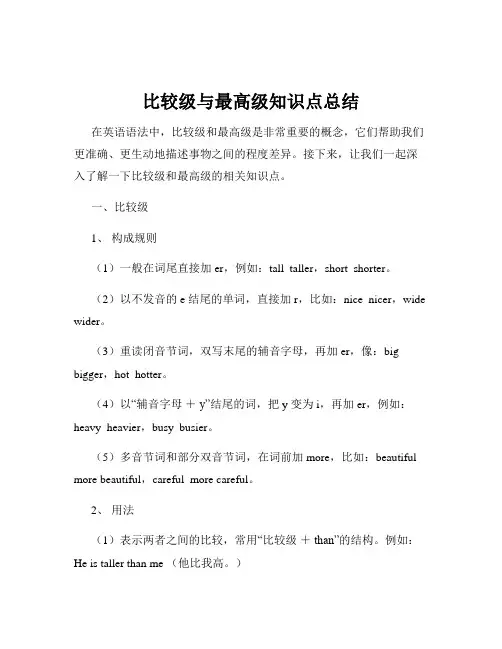
比较级与最高级知识点总结在英语语法中,比较级和最高级是非常重要的概念,它们帮助我们更准确、更生动地描述事物之间的程度差异。
接下来,让我们一起深入了解一下比较级和最高级的相关知识点。
一、比较级1、构成规则(1)一般在词尾直接加 er,例如:tall taller,short shorter。
(2)以不发音的 e 结尾的单词,直接加 r,比如:nice nicer,wide wider。
(3)重读闭音节词,双写末尾的辅音字母,再加 er,像:big bigger,hot hotter。
(4)以“辅音字母+y”结尾的词,把 y 变为 i,再加 er,例如:heavy heavier,busy busier。
(5)多音节词和部分双音节词,在词前加 more,比如:beautiful more beautiful,careful more careful。
2、用法(1)表示两者之间的比较,常用“比较级+than”的结构。
例如:He is taller than me (他比我高。
)(2)比较级前可以用much,a lot,far,even,a little 等词来修饰,表示程度上的差异。
例如:She is much more beautiful than her sister(她比她妹妹漂亮得多。
)(3)“the +比较级,the +比较级”,表示“越……,越……”。
比如:The more you read,the more you know (你读得越多,知道得就越多。
)二、最高级1、构成规则(1)一般在词尾直接加 est,例如:tall tallest,short shortest。
(2)以不发音的 e 结尾的单词,直接加 st,比如:nice nicest,wide widest。
(3)重读闭音节词,双写末尾的辅音字母,再加 est,像:big biggest,hot hottest。
(4)以“辅音字母+y”结尾的词,把 y 变为 i,再加 est,例如:heavy heaviest,busy busiest。
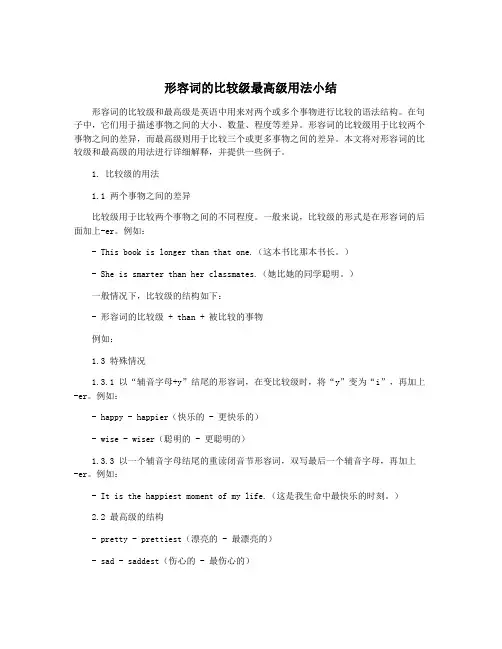
形容词的比较级最高级用法小结形容词的比较级和最高级是英语中用来对两个或多个事物进行比较的语法结构。
在句子中,它们用于描述事物之间的大小、数量、程度等差异。
形容词的比较级用于比较两个事物之间的差异,而最高级则用于比较三个或更多事物之间的差异。
本文将对形容词的比较级和最高级的用法进行详细解释,并提供一些例子。
1. 比较级的用法1.1 两个事物之间的差异比较级用于比较两个事物之间的不同程度。
一般来说,比较级的形式是在形容词的后面加上-er。
例如:- This book is longer than that one.(这本书比那本书长。
)- She is smarter than her classmates.(她比她的同学聪明。
)一般情况下,比较级的结构如下:- 形容词的比较级 + than + 被比较的事物例如:1.3 特殊情况1.3.1 以“辅音字母+y”结尾的形容词,在变比较级时,将“y”变为“i”,再加上-er。
例如:- happy - happier(快乐的 - 更快乐的)- wise - wiser(聪明的 - 更聪明的)1.3.3 以一个辅音字母结尾的重读闭音节形容词,双写最后一个辅音字母,再加上-er。
例如:- It is the happiest moment of my life.(这是我生命中最快乐的时刻。
)2.2 最高级的结构- pretty - prettiest(漂亮的 - 最漂亮的)- sad - saddest(伤心的 - 最伤心的)- 比较级用于比较两个事物之间的差异,最高级用于比较三个或更多事物之间的差异。
- 形容词的最高级的结构是:the + 形容词的最高级 + 名词。
- 在变比较级和最高级时,以“辅音字母+y”结尾的形容词将“y”变为“i”,以“e”结尾的形容词直接加上-r或-st,以一个辅音字母结尾的重读闭音节形容词双写最后一个辅音字母。
- 比较级和最高级在句子中可用于描述事物的大小、数量、程度等差异。
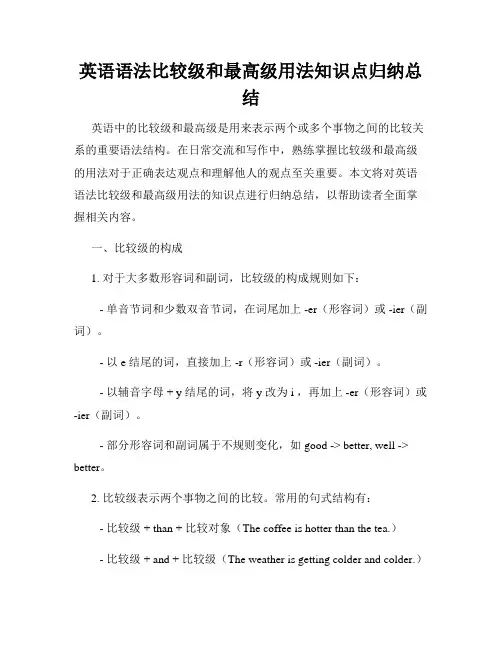
英语语法比较级和最高级用法知识点归纳总结英语中的比较级和最高级是用来表示两个或多个事物之间的比较关系的重要语法结构。
在日常交流和写作中,熟练掌握比较级和最高级的用法对于正确表达观点和理解他人的观点至关重要。
本文将对英语语法比较级和最高级用法的知识点进行归纳总结,以帮助读者全面掌握相关内容。
一、比较级的构成1. 对于大多数形容词和副词,比较级的构成规则如下:- 单音节词和少数双音节词,在词尾加上 -er(形容词)或 -ier(副词)。
- 以 e 结尾的词,直接加上 -r(形容词)或 -ier(副词)。
- 以辅音字母 + y 结尾的词,将 y 改为 i ,再加上 -er(形容词)或-ier(副词)。
- 部分形容词和副词属于不规则变化,如 good -> better, well -> better。
2. 比较级表示两个事物之间的比较。
常用的句式结构有:- 比较级 + than + 比较对象(The coffee is hotter than the tea.)- 比较级 + and + 比较级(The weather is getting colder and colder.)- more + 形容词 / 副词(More and more people are interested in learning English.)二、最高级的构成1. 对于大多数形容词和副词,最高级的构成规则如下:- 在比较级基础上加上 -est(形容词)或 -iest(副词)。
- 以 e 结尾的词,直接加上 -st(形容词)或 -iest(副词)。
- 以辅音字母 + y 结尾的词,将 y 改为 i ,再加上 -est(形容词)或 -iest(副词)。
- 部分形容词和副词属于不规则变化,如 good -> best, well -> best。
2. 最高级表示三个或三个以上事物之间的比较。
常用的句式结构有:- the + 最高级 + of + 比较对象(He is the tallest of all the students.) - 形容词 / 副词 + in / of + 最高级(She is the most beautiful girl inthe class.)- 形容词 / 副词 + of + all(It is the most expensive car of all.)三、比较级和最高级的用法1. 用于形容词和副词,表示大小、程度、数量等方面的比较。
高中英语知识点归纳比较级和最高级的特殊形式特殊形式:比较级和最高级的特殊构成和应用比较级和最高级是英语中常用的两种形容词和副词级别。
除了一般形式之外,它们还可以存在一些特殊的形式。
了解这些特殊形式,能够帮助我们更好地理解和运用比较级和最高级。
本文将归纳总结比较级和最高级的特殊形式及其适用情况。
1. 比较级和最高级的“更…(than)”结构这种结构常用于比较级中,表示比上一个程度更高或更低。
例如:- Mary is more intelligent than her sister.- The weather is colder today than yesterday.2. 比较级和最高级的“the+比较级…(the)+最高级”结构这种结构用于比较级和最高级之间进行对比,强调相对差异。
例如:- The more you practice, the better your performance will be.- The earlier you submit the assignment, the higher your grade will be.3. 比较级和最高级的“形容词/副词+比较级…(than)+any other”结构这种结构用于对比两个以上的事物中,指出某个特定事物比其他任何事物都更具有某种性质。
例如:- This is the tastiest cake I have ever eaten. I haven't had any other cake that is as tasty as this one.- Tom speaks English more fluently than any other student in his class.4. 比较级和最高级的“the+序数词(基数词)+最高级”结构这种结构用于表示在整个序列或某个群体中位于第几位。
例如:- Emma is the tallest girl in her class.- This is the first time I have seen such a beautiful sunset.5. 比较级和最高级的“比较级+and+比较级”结构这种结构用于强调比较级的程度更高。
高中英语知识点归纳比较级和最高级的常见用法英语中比较级和最高级是表示程度、大小、数量等方面差异的重要方式。
掌握比较级和最高级的常见用法对于高中英语学习来说至关重要。
本文将对比较级和最高级的常见用法进行归纳和总结。
一、形容词和副词的比较级和最高级形式1. 比较级比较级是形容词和副词用于比较两个事物时的形式。
一般情况下,我们在形容词和副词前加上-er来构成比较级形式,例如:taller(更高的)、faster(更快的)。
特殊情况下,需要在形容词或副词前加上more来表示比较级形式,例如:more beautiful(更漂亮的)、more carefully(更仔细地)。
2. 最高级最高级是形容词和副词用于比较三个或三个以上事物时的形式。
一般情况下,我们在形容词和副词前加上-est来构成最高级形式,例如:tallest(最高的)、fastest(最快的)。
特殊情况下,需要在形容词或副词前加上most来表示最高级形式,例如:most beautiful(最漂亮的)、most carefully(最仔细地)。
二、比较级和最高级的用法1. 比较级的用法比较级常用于以下情况:- 表示两个人或两个物品之间的比较。
例如:Tom is taller than John.(汤姆比约翰高。
)- 表示两个动作之间的比较。
例如:She runs faster than him.(她跑得比他快。
)- 表示两个性质不同的事物之间的比较。
例如:Learning English is more difficult than learning Chinese.(学习英语比学习中文更难。
)2. 最高级的用法最高级常用于以下情况:- 表示三个或三个以上人或物之间的比较。
例如:She is the tallest girl in the class.(她是班里最高的女孩。
)- 表示某一事物在同一范围内的最高程度。
例如:This is the most beautiful place I have ever seen.(这是我见过的最美丽的地方。
形容词的比较级最高级用法小结形容词的比较级和最高级是英语语法中常见的两个概念,通常用于比较度量事物之间的差异和相对大小。
比较级表示两个事物之间的大小、数量、强度等差异,而最高级则用于表示同类事物中最高的那一个。
一、比较级的用法1.多音节和部分双音节词的比较级用“more+原级形容词”。
例如:delicious(美味的)→more delicious(更美味的);expensive(昂贵的)→more expensive(更昂贵的)。
例如:big(大)→bigger(更大的);fast(快的)→faster(更快的)。
3.以“不规则形式”变化的形容词,其比较级会采用不规则的形式。
4.比较级常用于表示动词的速度、级别、强度等方面的变化。
例如:She runs faster than her brother.(她跑得比她哥哥快。
);His English is better than mine.(他的英语比我好。
)5.注意一些特殊的变化方式。
例如:far(远的)→furth er/farther(更远的);old(老的)→older/elder(更老的);late(晚的)→later/latest(更晚的)。
最高级用法和比较级类似,是用于形容词和副词之间的比较,但是最高级的范围是一个群体内的所有对象中选择最具有代表性的一个,表示最高的状态、品质等。
1.单音节形容词一般在词尾加-est构成最高级。
2.对于多音节词的最高级,则是在其前面加“the most”。
3.与比较级相似,有些最高级形式也有不规则形式。
例如:good(好的)→the best(最好的);bad(坏的)→the worst(最糟的);little(小的)→the least(最少的)。
4.最高级可以通过加上“in”的介词短语来表示在一定范围内的最高级状态。
5.一些最高级形式有与比较级不同的陈述方式,最常见的是加上“of all”。
总结形容词的比较级和最高级常常用于英语的口语和写作当中,用法也比较灵活。
常见形容词的比较级和最高级有哪些常见形容词的比较级和最高级有哪些最高级表示三者或三者以上的人或物进行比较时,用最高级,是几个比较的事物中最……的意思。
下面是店铺整理的形容词的比较级和最高级,希望能帮到大家!规则变化:fast→faster→fastestbig→bigger→biggesthot→hotter→hottesdry→drier→driestcalm→ calmer →calmestwild →wilder→ wildestserious→ more serious→ most seriousathletic→ more athletic →most athleticnecessary→ more necessary →most necessarypoor→poorer→poorest fast→faster→fastestfamous: →more famous,→ most famousquick:→ quicker →qu ickestearly:→ earlier →earliestfree →freer(freeer这个不常用)→ freestweak:→ weaker,→ weakestangry:→ angrier→ angriest不规则变化:Expensive—more expensive—most expensivehigh,higher,highest large,larger,largestwet, wetter,wettest busy,busier,busiestdelicious,more delicious,most deliciousheavy,heavier,heaviestdry,drier,driesteasy easier easiestlazy lazier laziestpretty prettier prettiestnaughty naughtier naughtiestmealy mealier mealiestearly earlier earliestthirsty thirstier thirstiestfar→farther→farthestfar→further→furthestDull—duller--dullestLoud-louder--loudestBoring—more boring—most boringCreative—more creative—most creativeWarm---warmer--warmestgood / well→better→bestbad / ill→worse→worstmany / much→more→mostlittle→less→leastlate→later→ / latestlate→latter→last【拓展】关于形容词和副词的比较级一、含义1. 大多数形容词和副词有三个等级:原级、比较级、最高级: good – better - best2. 比较级:表示两者(人或物)之间的比较。
形容词的比较级最高级用法小结比较级是形容词的一种屈折变化形式,表示两个或多个事物之间的比较程度。
最高级则表示三个或以上事物之间的最高程度。
下面是形容词的比较级和最高级的用法小结:一、比较级的用法:1. 基本用法:比较级表示两者之间的比较关系,常用结构为“形容词+er+than”。
例句:She is smarter than her brother.(她比她的哥哥聪明。
)例句:He had more than 10 books.(他有10余本书。
)3. 表示过去的变化:将比较级与动词过去时连用,表示过去某个时刻进行的比较。
例句:It was getting colder and colder last winter.(去年冬天越来越冷。
)4. 表示方向的比较:将比较级与介词“than”连用,表示方向上的比较。
6. 特殊比较级形式:有些比较级的形式与原形不同。
例句:good → better(好→ 更好)7. 不完全比较:在一些情况下,比较级没有与之比较的对象,表示的是一种倾向性、趋势。
8. 比较句型:在比较句型中,比较级常用在主语和系动词的后面,表示主语在某一方面的特点。
2. 基数词最高级:形容词的最高级前面可以加上基数词来表示具体的数目。
3. 广义最高级:有些形容词的最高级在修饰范围上可以具有一定的广义。
4. 最高级的句中用法:在最高级句中,最高级可以置于句首,表达一种强调的语气。
6. 比较级与最高级的比较:比较级表示两者之间的比较关系,而最高级是在三者或多者之间的最高程度比较。
例句:He is taller than his brother, but not the tallest in his class.(他比他的哥哥高,但不是班里最高的。
)以上就是形容词的比较级和最高级的用法小结。
形容词的比较级和最高级可以帮助我们描述事物之间的大小、高低、好坏等比较关系,使语言更加生动形象。
形容词的比较级最高级用法小结形容词的比较级和最高级是英语中常用的语法结构,用来对两个或多个事物进行比较和表达最高程度的描述。
掌握好比较级和最高级的用法,能够让我们的表达更加准确和生动。
本文将对形容词的比较级和最高级的用法进行小结,帮助读者更好地理解和运用这一语法知识。
一、比较级的用法1. 比较级的构成比较级的构成方式一般是在形容词后面加上-er或者在形容词前加上more,例如:taller, more beautiful。
在构成比较级时,单音节词一般直接在词尾加-er,多音节词则需要在前面加上more。
比较级用来表示两者之间的比较,通常使用than来引导比较的对象,例如:My house is bigger than yours. 意为“我的房子比你的大”。
有些形容词的比较级形式有些特殊,需要记住其规则变化,例如good的比较级是better,bad的比较级是worse等。
2. 最高级的用法三、比较级和最高级的不规则形式除了上述提到的一般规则外,还有一些形容词的比较级和最高级形式是不规则的,需要特殊记忆,例如:原级比较级最高级good better bestbad worse worstfar farther farthest/furthestlittle less leastmuch/many more mostold older oldest四、注意事项1. 注意形容词原级的拼写变化,比如以“y”结尾的形容词比较级直接变成“ier”,最高级变成“iest”;2. 在使用比较级和最高级时,需要明确比较的对象,并使用合适的介词来引导;3. 特殊情况需要牢记,例如good和bad等形容词的比较级和最高级的不规则变化;4. 以上规则只针对一般的形容词,对于复合形容词和副词的比较级和最高级形式,需要根据具体情况进行变化。
通过对比较级和最高级的小结,相信读者对于这一语法知识有了更深入的理解。
在实际运用中,我们需要不断积累词汇,灵活运用比较级和最高级,从而使我们的表达更加生动和精准。
常用形容词比较级结构小结1.当as… as 中有名词时as +形容词+ a +单数名词/as + many/much +名词This is as good an example as the other is.I can carry as much paper as you can..2. 倍数+ as + adj. + as= 倍数+ the+ of,表示倍数的词或其他程度副词做修饰语时放在as前This room is twice as big as that one. (Your room is the same size as mine.)This bridge is three times as long as that one. (This bridge is three times the length of that one. )Your room is twice as large as mine.( Your room is twice the size of mine.)3.可修饰比较级的词 a bit, a little, much, a lot, still, even,far等4.many,old 和far1) 如果后接名词时,much more +不可数名词;many more +可数名词复数2) old 有两种比较级和最高级形式: older/oldest 和elder/eldest,elder,eldest 只用于兄弟姐妹的长幼关系。
My elder brother is an engineer.3) far 有两种比较级,farther,further. 在英语中两者都可指距离。
在美语中,father 表示距离,further 表示进一步。
I have nothing further to say.5.the + 最高级+ 比较范围The Sahara is the biggest desert in the world.形容词最高级前通常必须用定冠词the,副词最高级前可不用。
形容词most前面没有the,不表示最高级的含义,只表示"非常"。
It is a most important problem. =It is a very important problem.6.“the +形容词”的两种用法“the+形容词”既可以等同于复数普通名词,也可以等同于抽象名词,代表一类人或事。
The rich are apt to look down upon the poor.富人常常轻视穷人。
The poet had an yearning for the supernatural.诗人憧憬超自然的东西。
这种用法也可以适用于“the+现在分词”及“the+过去分词”。
The unexpected always happens. 天有不测风云。
The wounded and the dying were rushed to hospital. 受伤的人和垂死的人被急送到医院去了。
+比较级+理由” 7. “the该句型具有“更加”的意思。
常以“all (或much) the+比较级”的形式出现。
例如:I am the more inclined to help him because he is poor. 因为他穷,我更想帮他。
It is all the more dangerous for not being generally recognized as such.一般不认为危险的,反而更加危险。
该句型的意思为“越……越……”。
例如:8.“the+比较级...,the+比较级...”The more he flatters me,the less I like him.他越是迎合我,我越不喜欢他。
The higher the mountain is, the more people like to climb it; the more dangerous the mountain is, themore they wish to conquer it.山越高,人越想爬;山越危险,人越想征服它。
这种句型常用省略说法,The sooner,the better.越快越好。
More haste,less speed. 欲速则不达。
9.“the last+不定式/形容词从句”。
意思是“最不大可能的、最不适的”。
Money is the last thing he wants, and you won’t succeed by offering it.他决不要钱,你想用钱去买动他是决不可能的。
The author should be the last person to talk about his work.作者最不宜讨论他的作品。
10.序数词通常只修饰最高级。
Africa is the second largest continent.11.否定词语+比较级","否定词语+ so… as"结构表示最高级含义Nothing is so easy as this=Nothing is easier than this. =This is the easiest thing.12.. more词组1) the m ore… the more… 越……就越…… The harder you work,the greater progress you’ll make.不如…… 2) no more… than…不比……多/ no less… than… The officials could see no more than the Emperor.He is no less diligent than you.3) more than不只是,非常She is more than kind to us all.13.“so+形容词/副词+that” 之后表示结果。
例如:在“so”后接形容词和副词表示因果关系,“that”之前表示原因,“that”Those ponds and streams are so small that they cannot be shown in your maps.那些池塘和小溪太小,所以你的地图上没有。
He had lived so long in Asia that he had forgotten his English way of life.他在亚洲住得太久,所以英国的生活习惯都已经忘记了。
理解为“如此……以至于” 14. “so much so that” The patient was very tired when he returned from the ride, so much so that he could not sit up.病人坐车回家时非常疲倦,疲倦得甚至不能坐起来。
He is poor, so much so that he can hardly get enough to live.他很穷,穷得几乎难以生活下去。
15.“more+原级+than” 这种句型一般将不同性质加以比较,可以理解为“与其说……不如说”。
例如:He is more witty than wise.与其说他聪明,不如说他机智。
He is more dead than alive. 与其说他活着,不如说他死了。
16.“much more”和“much less” 以上两种表达法都有“更加”的意思。
“much more”用于肯定句,表示程度加强;“much less”用于否定句,表示程度减少。
例如:I like music, much more dancing.我喜欢音乐,更喜欢跳舞。
I don't like music, much less dancing.我不喜欢音乐,更不喜欢跳舞。
和“ would as soon...as” 均可理解为“宁愿……也不”。
17..“would sooner(rather)...than”He would rather(sooner) resign than take part in such dishonest business deals.他宁可辞职也不干这种不正当的勾当。
I would as soon die as disgrace myself.我宁死不受辱。
和“scarcely... before” 18.“no sooner...than”、“hardly...when”以上三个句型的意思是“一……就”。
应当注意的是,在以上句型中,句子的前半部分一般用过去完成时,而后半部则用一般过去时。
该句型通常采用倒装语序。
No sooner had I opened the cage than the little bird flew out.=Scarcely(Hardly) had I opened the cagebefore (when ) the little bird flew out.我一开笼小鸟就飞出去了。
和“all but” 19.“anything but”、“nothing but”。
英语中,“anything but”=never,“ nothing but”=only, “all but”=almost, nearlyHe is anything but a scientist.他决不是科学家。
I am nothing but a student.我不过是个学生。
He is all but a fool.他几乎是个傻瓜。
不用“than” 20.prior、superior 、inferior 、senior 和junior 表示比较时后面用“to”“prior to”意思是优于,高于;意思是早于,比……重要;“superior to”意思是年长于,地位高于;“inferior to”意思是次于;“senior to ”“junior to”意思是年幼于,地位低于,迟于。
The task is prior to all others.这项任务比其他所有的任务都重要。
In maths he felt superior to John. 他觉得自己数学比约翰强。
These apples are inferior in flavor to those. 这些苹果的味道不如那些。
He is two years senior to me. 他比我大两岁。
21.much,more,most(1) more和most的用法相当自由:You should ride more.你必须多骑马。